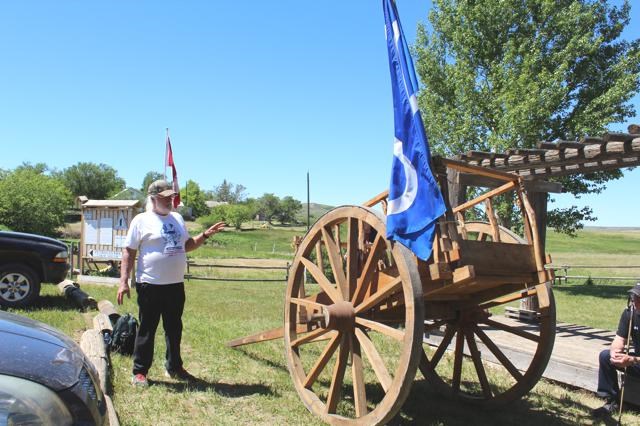The Friends of the St. Victor Petroglyphs held a grand opening of a Red River cart display at the St. Victor Petroglyphs Interpretive Centre in St. Victor on August 26. The day included an opening of the display and a dedication ceremony. Builder of the cart, Brian Kuysten, was on hand to answer questions and visit. Visitors were invited to stay for a barbecue of smokies on a bun.
The Red River Cart: A Hero of the Plains
Submitted by David L Munro
According to the journal of the North West Company fur trader Alexander Henry the younger, the Red River Cart made its first appearance at Fort Pembina just south of the Manitoba-North Dakota Border in 1801. The Red River cart may have been derived from the charrettes used in French Canada or the cart used by the Scottish descendants of Lower Canada. Made from local wood and built without the use of iron due to its cost, they were easily repaired along the cart trails across the prairies. The larger carts could carry loads of furs and materials weighing up to 1,000 lbs., or 450 kg, moving at a slow steady pace pulled by oxen.
The first carts were pulled by small horses obtained from the First Nations people just west of the joining of the Red and Assiniboine Rivers in Manitoba. After the establishment of the Selkirk Settlement, oxen became the main power to pull the carts due to their strength, stamina and split hooves which aided in movement through mud.
The squeal of 300 to 500 carts created by the rubbing of the wooden axels sounded like a group of untuned violins and was nicknamed the “North West Fiddle”. Some said they were heard three miles away and if up wind could be smelled five miles away.
Red River Carts passed through St. Victor on their way to Wood Mountain and on to Cypress Hills. On one such trek, they hauled some 800 Plains Grizzly furs and over 2,000 bison hides. Part of this wagon trail is still evident near St. Victor. Part of this trail will become an outdoor mural on the shed which will house a Red River Cart at Monarch Lodge in St. Victor. This cart was built by Brian Kuysten and donated to the Friends of the St. Victor Petroglyphs.



